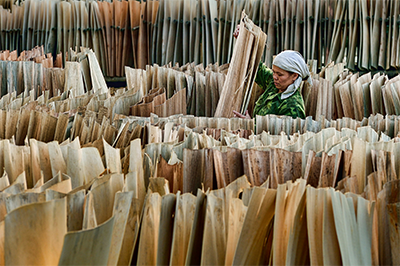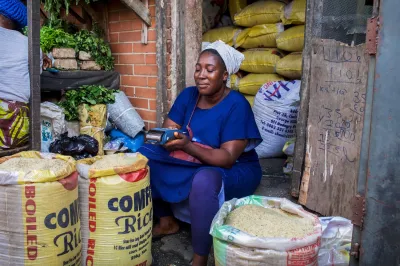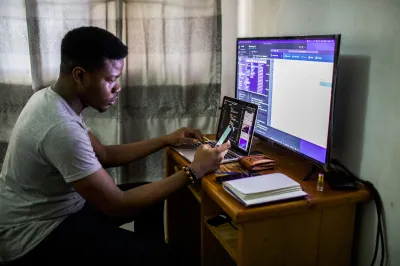Open Banking: 7 Ways Data-Sharing Can Advance Financial Inclusion
As the global discussion unfolds about how “open banking” may transform the banking sector, CGAP's focus has been on open banking’s potential to improve the lives of people with low incomes in emerging markets. Do open-banking-enabled products solve specific pains for these customers? Our early research indicates that when firms can access customers’ financial data held by third parties, these firms create savings, credit and financial management products that are better suited to poor people than those traditional banks have to offer. These products are especially important today in a COVID-19 (coronavirus) world.
What is an open banking regime?

We define open banking regimes as data-sharing schemes that are mandated or supported by regulators with a goal of creating competition and fostering innovation in financial services. Within an open banking regime, banks and other financial institutions (data holders) exchange consumer data with other financial services providers (FSPs) or third-party providers like fintechs (both known as “data recipients”), following applicable laws and regulations on consumer consent. We exclude purely voluntary private sector schemes from our definition, as there is no regulatory involvement. Data obtained through open banking can inform the design or terms and conditions of products. Popular examples include personal finance and budgeting applications like Mint and credit score monitoring services such as Creditkarma, but there are many other types.
There are many initiatives to create open banking regimes in developed countries. The first movers include Australia, the European Union and the United Kingdom. Their experiences with open banking are encouraging from a financial inclusion standpoint. A recent report in the United Kingdom found that those “on the margins” of financial inclusion (those with no account or only a basic account) are likely to pay less in fees by using open banking — saving the equivalent of 0.8 percent of their income — while those who are “overstretched” (those with an account who are heavily indebted) would save the equivalent of 2.5 percent of their income. The report concludes that open banking could improve financial inclusion and drive value for these segments by helping them control their finances, obtain better deals and manage their debts.
How might open banking regimes advance financial inclusion in emerging markets?
The global evidence we’ve reviewed suggests that by responsibly sharing customer transaction data, fintechs and other types of financial institutions can do a better job than traditional banks of offering products and promoting financial behaviors that alleviate some of the pain points experienced by low-income customers. Examples include:
- Smoothing volatile incomes. Open banking may enable products that can help low-income customers save, creating a financial cushion to smooth income and improve resilience to shocks. These include savings trackers (see Meerkat in South Africa) and automatic savings sweepers that calculate what a consumer can save and when, based on their financial history, and then automatically transfer those funds to a dedicated savings account (a product provided by the U.S. fintech Digit).
- Lowering tariffs on household bills. Many families in emerging markets pay a “poverty premium” for essential goods and services, such as telephone, gas, electricity and broadband. Open banking products that analyze spending patterns, identify opportunities for saving money, negotiate new contracts on a consumer’s behalf and cancel their old subscriptions can handle both demand- and supply-side factors that create such a premium in the first place. Trim is an example in the United States.
- Overcoming lack of documentation. Onerous customer due diligence (CDD) procedures can result in high costs for low-income customers or prevent them from accessing financial services. Brazil’s open banking regime foresees a collaborative approach to CDD by allowing FSPs to share registration data. If open banking regimes expand to include telecommunications, social media or other types of data, then SIM card registration or other methods of CDD could come into play as long as simplified know-your-customer (KYC) approach is allowed.
- Encouraging healthy financial behaviors. Personal finance and budgeting applications can empower consumer insights generated from consumer transaction data. When such applications are permitted to initiate transactions on behalf of the customer from his or her financial account, consumers can put these insights into practice in a seamless and user-friendly fashion. In the European Union, Yolt Pay allows users of the Yolt budgeting app to initiate money transfers using open banking APIs, while Guiabolso in Brazil allows customers to obtain a suitable loan directly from its application.
- Responsibly expanding access to credit. If properly designed, open banking products can expand access to credit that helps, rather than harms, consumers through the use of alternative financial data. In the United Kingdom, Mojo Mortgages combines open banking data with more widely used scoring methods to accurately assess what a customer can afford, while Canopy uses consumer rent payments to improve their credit score, a metric previously excluded by most large credit bureaus.
- Supporting debt rehabilitation services. Providers such as Tully in the United Kingdom and Meerkat in South Africa use open banking data to build a customer’s budget, identify loans that can be refinanced or consolidated and negotiate affordable repayment schedules on the customer’s behalf. If such services are coupled with payment initiation, then “smart loan repayment” can be introduced. These are debt repayment plans that can account for fluctuations in income of the customer during repayment periods, allowing customers to pay more or less based on their available liquidity, without triggering default provisions.
- Reducing reliance on overdrafts and other excessively priced credit products. Rebel’s Tapa Buraco service in Brazil alerts customers if they are overdrawn. Customers can then access a prequalified 30-day interest-free loan on the balance and benefit from a reduced interest rate thereafter. Consumers also can find optimal interest rates and loan fees that fit their circumstances by using apps such as Afluenta in Argentina and Creditkarma in the United States.
These solutions are particularly pertinent in a COVID-19 world. Financial management tools, for instance, can help people with low incomes better manage their limited resources when incomes are severely constrained. Credit products can cover immediate liquidity needs responsibly. Lastly, savings products can make people more resilient in and better prepared for hard times.
Many of these solutions are predicated on smartphone access, especially those that rely on data visualization. However, smartphone users are still the exception rather than the rule in emerging markets. For example, only 45 percent of phone owners in Sub-Saharan Africa had adopted smartphones in 2018. In theory, owners of feature phones can still take advantage of some of these services. Many open-banking-enabled products — such automatic savings sweeping, smart loan repayment and decentralized KYC — use data only on the back-end and do not require the consumer to own a smartphone. Others, such as switching utilities or personal finance management could work on SMS or USSD menus with limited functionality.
However, there are limits to the applicability of open banking in emerging markets. Data are another prerequisite for open banking products, of course, and many low-income customers have no digital financial data trails. For this reason, it is important to consider how other types of digital data — whether social media activity, airtime purchases or utility payments — could ultimately be leveraged by open banking regimes.




Add new comment